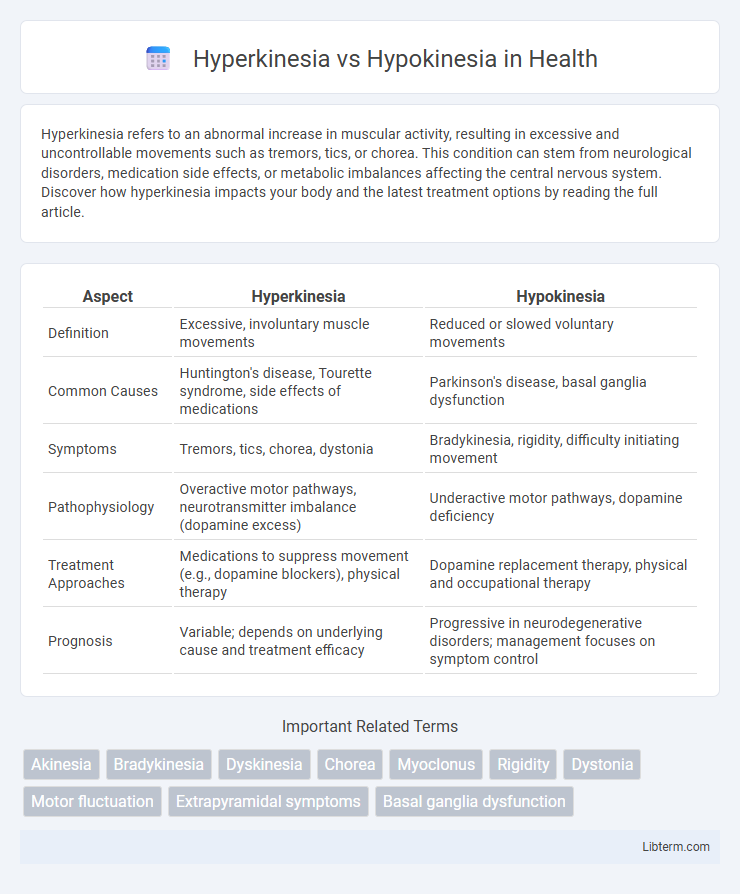Hyperkinesia refers to an abnormal increase in muscular activity, resulting in excessive and uncontrollable movements such as tremors, tics, or chorea. This condition can stem from neurological disorders, medication side effects, or metabolic imbalances affecting the central nervous system. Discover how hyperkinesia impacts your body and the latest treatment options by reading the full article.
Table of Comparison
| Aspect | Hyperkinesia | Hypokinesia |
|---|---|---|
| Definition | Excessive, involuntary muscle movements | Reduced or slowed voluntary movements |
| Common Causes | Huntington's disease, Tourette syndrome, side effects of medications | Parkinson's disease, basal ganglia dysfunction |
| Symptoms | Tremors, tics, chorea, dystonia | Bradykinesia, rigidity, difficulty initiating movement |
| Pathophysiology | Overactive motor pathways, neurotransmitter imbalance (dopamine excess) | Underactive motor pathways, dopamine deficiency |
| Treatment Approaches | Medications to suppress movement (e.g., dopamine blockers), physical therapy | Dopamine replacement therapy, physical and occupational therapy |
| Prognosis | Variable; depends on underlying cause and treatment efficacy | Progressive in neurodegenerative disorders; management focuses on symptom control |
Introduction to Hyperkinesia and Hypokinesia
Hyperkinesia manifests as excessive, involuntary movements often seen in disorders such as Huntington's disease and tardive dyskinesia, highlighting abnormal basal ganglia function. Hypokinesia, characterized by reduced movement or slowed initiation, is a hallmark of Parkinson's disease and results from dopaminergic neuron degeneration in the substantia nigra. Understanding the contrasting motor symptoms of hyperkinesia and hypokinesia provides insight into underlying neurodegenerative mechanisms and guides targeted therapeutic interventions.
Definition of Hyperkinesia
Hyperkinesia is characterized by excessive, involuntary movements resulting from abnormal activity in the basal ganglia or motor pathways, often seen in conditions like Huntington's disease and chorea. In contrast, hypokinesia involves a reduction in movement amplitude and speed, commonly associated with Parkinson's disease. Understanding hyperkinesia's neural mechanisms aids in distinguishing it from hypokinesia, guiding targeted therapeutic interventions.
Definition of Hypokinesia
Hypokinesia is characterized by reduced movement or diminished amplitude of voluntary motion, often observed in neurological disorders such as Parkinson's disease. It manifests as slowness in initiating and executing movements, contributing to motor impairments like bradykinesia and freezing episodes. In contrast, hyperkinesia involves excessive, involuntary movements, highlighting the spectrum of motor control abnormalities.
Key Differences Between Hyperkinesia and Hypokinesia
Hyperkinesia is characterized by excessive, involuntary movements such as tremors, tics, or chorea, often resulting from basal ganglia dysfunction. Hypokinesia involves reduced movement amplitude and slowed initiation, commonly seen in Parkinson's disease due to dopamine deficiency in the nigrostriatal pathway. The key differences lie in movement quantity and control: hyperkinesia causes increased, uncontrolled motions while hypokinesia leads to diminished, slow, and rigid motor activity.
Causes of Hyperkinesia
Hyperkinesia is characterized by excessive involuntary movements caused primarily by neurological disorders such as Huntington's disease, Tourette syndrome, and certain forms of cerebral palsy. It results from dysfunction in the basal ganglia, leading to an imbalance between excitatory and inhibitory pathways in motor control circuits. Genetic mutations, neurodegeneration, and exposure to certain drugs like levodopa or stimulants can also trigger hyperkinetic symptoms.
Causes of Hypokinesia
Hypokinesia, characterized by reduced movement, primarily results from neurological disorders such as Parkinson's disease, where dopamine-producing neurons in the substantia nigra degenerate. Other causes include stroke, progressive supranuclear palsy, and medication side effects affecting motor pathways. Understanding these etiologies helps differentiate hypokinesia from hyperkinesia, which involves excessive involuntary movements.
Symptoms and Clinical Manifestations
Hyperkinesia presents with excessive, involuntary movements such as chorea, tremors, and tics, often causing difficulty in voluntary motor control and coordination. Hypokinesia is characterized by reduced movement amplitude and speed, evident in conditions like Parkinson's disease, where patients exhibit bradykinesia, rigidity, and a mask-like facial expression. Both conditions reflect underlying dysfunctions in basal ganglia circuits but manifest through contrasting motor impairments affecting daily activities and quality of life.
Diagnostic Approaches for Movement Disorders
Diagnostic approaches for hyperkinesia and hypokinesia prioritize precise assessment through neuroimaging techniques such as MRI or PET scans to detect structural or functional abnormalities in the basal ganglia. Clinical evaluations incorporate standardized movement disorder rating scales including the Unified Parkinson's Disease Rating Scale (UPDRS) for hypokinesia and the Abnormal Involuntary Movement Scale (AIMS) for hyperkinetic movements. Electrophysiological studies such as electromyography (EMG) may further characterize muscle activity patterns, aiding differential diagnosis between hyperkinetic disorders like chorea and hypokinetic conditions like Parkinson's disease.
Treatment and Management Options
Treatment for hyperkinesia often involves medications such as dopamine-depleting agents or antipsychotics to reduce involuntary movements, while physical therapy enhances motor control and coordination. Hypokinesia management typically includes dopamine replacement therapies, such as levodopa, to improve motor activity, combined with occupational therapy to maintain daily functioning. Deep brain stimulation is a surgical option effective in managing both conditions by modulating abnormal brain activity and improving motor symptoms.
Prognosis and Quality of Life Considerations
Hyperkinesia, characterized by excessive, involuntary movements, often presents challenges such as social stigma and injury risk, impacting quality of life variably depending on severity and treatment response. Hypokinesia, marked by reduced movement and bradykinesia, commonly associated with Parkinson's disease, generally leads to progressive motor decline and increased dependency, with prognosis closely linked to early intervention and rehabilitation strategies. Both conditions require tailored management plans targeting symptom control and functional improvement to optimize long-term quality of life outcomes.
Hyperkinesia Infographic

 libterm.com
libterm.com